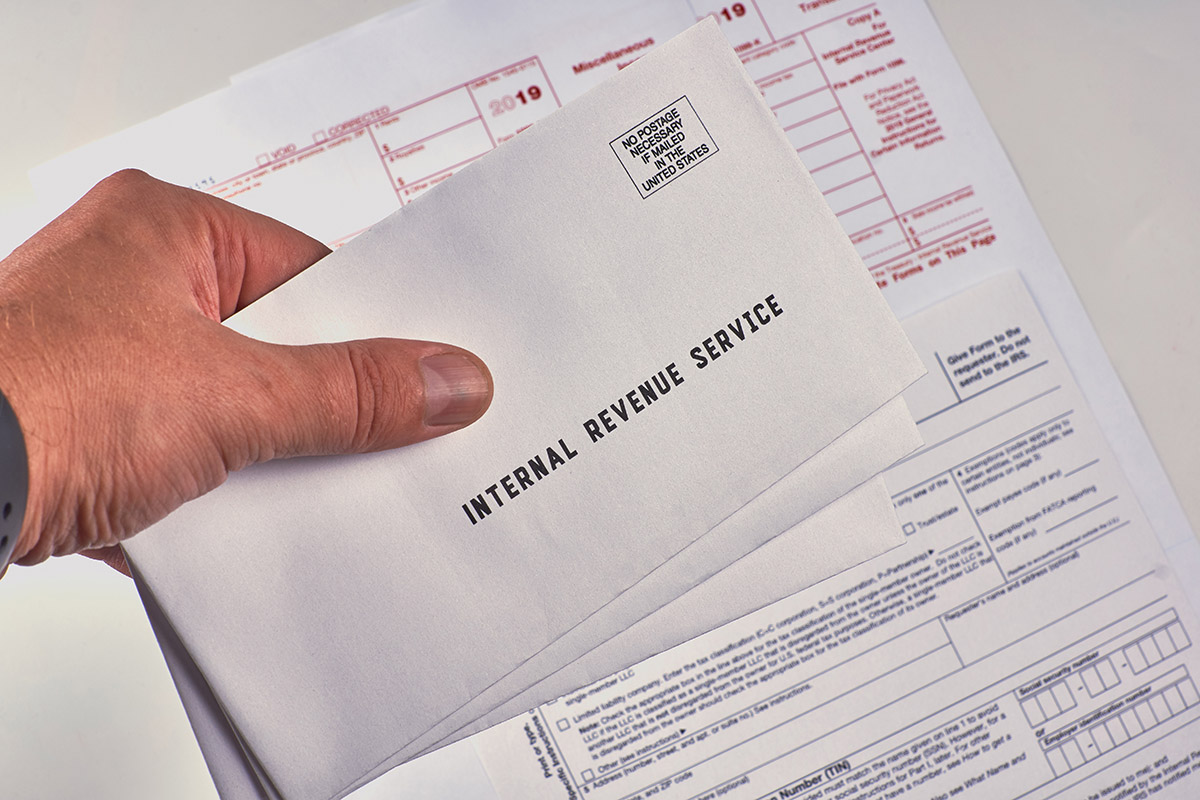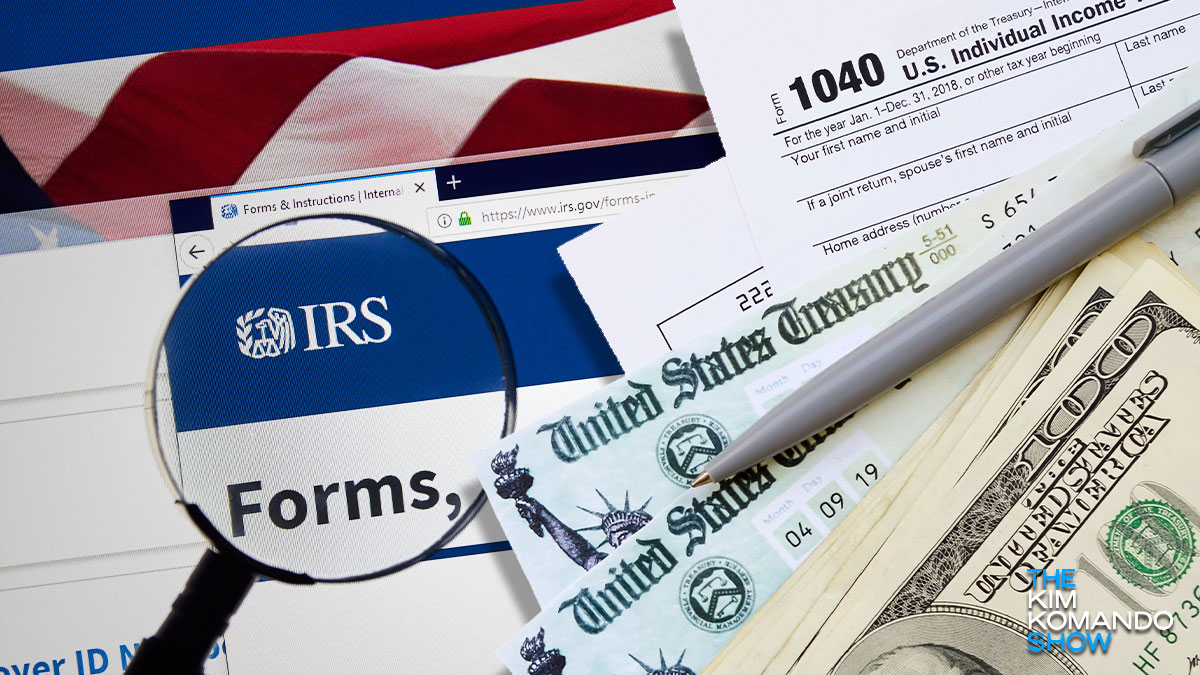

Finance
Tax Return Lost In Mail: What To Do
Published: October 29, 2023
Lost your tax return in the mail? Don't panic! Learn what steps to take next and ensure your finances are in order with our expert tips.
(Many of the links in this article redirect to a specific reviewed product. Your purchase of these products through affiliate links helps to generate commission for LiveWell, at no extra cost. Learn more)
Table of Contents
Introduction
Dealing with taxes can be a stressful process on its own, but what happens when your tax return gets lost in the mail? It can happen to anyone – the important documents you carefully prepared and sent off never reach their destination. Not only does this create anxiety and frustration, but it can also have serious consequences, such as missing out on potential refunds or facing penalties for late filing. However, you don’t have to panic. There are steps you can take to rectify the situation and ensure that your tax return is properly processed.
In this article, we will guide you through the appropriate steps to take when your tax return is lost in the mail. By following these steps, you can protect yourself from potential financial harm and ensure that the necessary actions are taken to resolve the issue. From contacting the post office to filing an amended return if needed, we will provide you with the necessary information to navigate through this challenging situation.
It’s important to note that although the likelihood of your tax return being lost in the mail is relatively low, the consequences can be significant. This is why it’s essential to be proactive and take immediate action to address the situation. By doing so, you can minimize potential complications and ensure that your tax return is properly recorded by the Internal Revenue Service (IRS).
Now, let’s delve into the steps you should take when your tax return goes astray.
Steps to Take When Tax Return is Lost in Mail
Discovering that your tax return has been lost in the mail can be a disheartening experience, but there are several steps you can take to address the situation effectively. By following these steps, you can ensure that your tax return is properly processed, and any potential issues are resolved.
- Contact the Post Office: The first step is to reach out to your local post office or the delivery service you used to send your tax return. Provide them with the necessary details, such as the tracking number or proof of postage. They can investigate the matter and attempt to locate your missing tax return. Keep any documentation or communication with the post office for future reference.
- Notify the IRS: It’s crucial to inform the Internal Revenue Service (IRS) about the situation. You can do this by contacting their helpline or visiting their website. Explain that your tax return has been lost in the mail and provide them with any relevant details. The IRS will guide you on the next steps to ensure that your tax return is properly processed.
- File an Extension: If the tax filing deadline is approaching and you haven’t received confirmation that your tax return was received, it’s advisable to file for an extension. This will give you additional time to resolve the issue and submit your tax return without facing any penalties for late filing. Remember, filing an extension does not mean you can delay paying any taxes owed.
- Reconstruct Your Tax Return: In the unfortunate event that your tax return cannot be located, you will need to reconstruct it. Gather all the necessary documentation, such as W-2 forms, 1099s, and other relevant receipts. Use these documents to recreate your tax return accurately. It’s advisable to seek assistance from a tax professional to ensure the accuracy and completeness of the reconstructed return.
- File an Amended Return if Necessary: If you later discover that your original tax return was not lost but was simply delayed or misplaced, you may need to file an amended return. Consult with a tax professional or review the guidelines provided by the IRS to determine if an amended return is necessary in your situation.
- Keep Important Documentation and Records: Throughout the process, it’s crucial to maintain copies of any communication, documentation, or records related to the lost tax return. This includes receipts, tracking numbers, and any correspondence with the post office or the IRS. These records will be crucial for any future inquiries or audits.
- Prevent Future Issues: To avoid future problems with lost tax returns, consider utilizing alternative methods for filing. E-filing your tax return is a secure and efficient way to ensure that your documents reach the IRS promptly. Additionally, consider using certified mail or registered mail when sending physical tax returns to minimize the risk of loss.
By following these steps, you can navigate through the challenging situation of a lost tax return and ensure that your tax obligations are fulfilled. Remember, seeking guidance from a tax professional is always a wise choice to ensure that you handle the situation correctly.
Contact the Post Office
When you discover that your tax return has been lost in the mail, the first course of action is to contact the post office. Reach out to your local post office or the delivery service you used to send your tax return. Provide them with any necessary information, such as the tracking number or proof of postage, to assist them in locating your missing tax return.
Start by calling the customer service helpline of the post office and explain the situation. Provide them with specific details, such as the date and location from where you sent the tax return, as well as the destination address. It’s essential to keep a record of the conversation, noting down the date, time, and the name of the representative you spoke to.
The post office will initiate an investigation to locate your missing tax return. They will check their processing centers, sorting facilities, and delivery routes to determine the whereabouts of your package. Their efforts may involve communicating with various departments and personnel, so it is important to provide as much information as possible to assist them in their search.
In some cases, the post office may require additional documentation, such as the original receipt or proof of mailing, to aid in their investigation. Be prepared to provide any requested information promptly to expedite the process.
It’s crucial to maintain open communication with the post office throughout the investigation. Follow up with them regularly to check on the progress of the search and obtain updates on any new developments. Patience is key during this process, as it may take some time for the post office to locate your tax return.
Keeping thorough documentation of your interactions with the post office is essential. Make notes of the dates and times of your conversations, the names of the representatives you spoke to, and any reference numbers provided. Having this information readily available will be helpful in case you need to escalate the matter or provide evidence of your attempts to resolve the issue.
By promptly contacting the post office and providing them with all relevant information, you increase the chances of locating your lost tax return. If, unfortunately, the post office is unable to locate it, you can proceed to the next steps to ensure that your tax obligations are fulfilled.
Notify the IRS
After contacting the post office and initiating a search for your lost tax return, the next step is to notify the Internal Revenue Service (IRS) about the situation. It’s crucial to inform the IRS promptly to ensure that your tax return is properly processed and any potential issues are addressed.
You can start by contacting the IRS helpline at the designated phone number or visiting their official website to report the loss of your tax return. Explain the situation and provide them with relevant details, such as the date of filing, the method of postage used, and any tracking numbers or proof of mailing you have. By providing this information, you assist the IRS in identifying your specific case and taking appropriate action.
The IRS may request additional documentation or evidence to support your claim that the tax return was lost in the mail. Be prepared to provide any relevant documents, such as receipts or proof of postage, to validate your case. Keeping thorough records of your communication with the IRS, including dates, times, and the names of the representatives you spoke with, is essential.
Once notified, the IRS will guide you on the next steps to ensure that your tax obligations are met. They may provide you with instructions on how to proceed, such as filing an extension, reconstructing your tax return, or submitting any additional information they require. It’s important to follow their guidance closely to minimize any potential penalties or delays in processing your tax return.
Throughout your correspondence with the IRS, it’s crucial to maintain polite and professional communication. Be patient and cooperative, as the IRS representatives are there to assist you and ensure that your tax return is properly accounted for. By staying proactive and responsive, you demonstrate your commitment to resolving the issue and fulfilling your tax obligations.
Remember to retain copies of any documentation or correspondence exchanged with the IRS. These records will be invaluable in the event of any future inquiries or audits. Additionally, note down any reference numbers or confirmation numbers provided by the IRS, as they can serve as evidence of your interaction and cooperation.
By promptly notifying the IRS about the loss of your tax return, you ensure that the necessary steps are taken to mitigate any potential issues. It’s essential to work collaboratively with the IRS to resolve the situation and fulfill your tax obligations in a timely and satisfactory manner.
File an Extension
If the tax filing deadline is approaching and you haven’t received confirmation that your tax return was received, it’s advisable to file for a tax extension. Filing an extension will grant you additional time to resolve the issue of your lost tax return and ensure that you can submit your taxes without facing any penalties for late filing.
To file for an extension, you can utilize Form 4868, Application for Automatic Extension of Time to File U.S. Individual Income Tax Return. This form can be found on the IRS website or obtained from a tax professional. Fill out the necessary information, including your name, Social Security number, and an estimate of your total tax liability.
When filing for an extension, it’s important to remember that it grants you additional time to file your tax return but does not extend the time to pay any taxes owed. If you anticipate owing taxes for the current tax year, you should make the estimated payment by the original tax filing deadline to avoid potential penalties and interest charges.
By filing for an extension, you gain an additional six months to submit your tax return. This allows you ample time to locate your lost tax return, reconstruct it, or take any necessary steps to resolve the situation. Note that filing an extension does not guarantee that any penalties or interest charges will be waived if you later file your tax return after the extension period.
When filing for an extension, be sure to check the specific requirements and due dates for your state taxes as well. Some states may have different forms or procedures for extension requests.
Remember, filing for an extension is a prudent step to take when your tax return has been lost in the mail. It provides you with the necessary time to resolve the issue and ensures that you can fulfill your tax obligations without facing any unnecessary penalties or consequences for late filing.
However, while the extension provides additional time, it’s important to proactively work towards resolving the situation and submitting your tax return in a timely manner to minimize any potential complications or concerns.
Reconstruct Your Tax Return
If your tax return has been lost in the mail and cannot be located, you will need to take steps to reconstruct it. This involves gathering all the necessary documentation and information to accurately recreate your tax return.
Start by collecting any relevant documents such as your W-2 forms, 1099s, and receipts for deductions and credits. These documents are essential for accurately reporting your income and claiming any eligible deductions or credits. If you don’t have physical copies of these documents, you may be able to obtain them from your employer, financial institutions, or other relevant sources.
Next, carefully review the information on your reconstructed tax return. Pay close attention to details such as your personal information, income sources, deductions, and credits. Use the documentation you have gathered to ensure accuracy and completeness.
It can be helpful to seek assistance from a tax professional when reconstructing your tax return. They have the expertise and knowledge to guide you through the process and ensure that your reconstructed return is accurate and compliant with tax laws. They can also help you identify any potential areas where you may be eligible for additional deductions or credits.
When reconstructing your tax return, maintain clear and organized records of the documentation you relied upon. Keep copies of any receipts, statements, or other supporting documents. These records will serve as evidence in case of any future inquiries or audits.
If you had filed any state or local tax returns alongside your federal return, you may need to reconstruct those as well. Check the specific guidelines and requirements for your state or local tax authorities to ensure that you accurately fulfill your obligations.
Once you have reconstructed your tax return to the best of your ability, double-check all the information for accuracy. Make sure to sign and date the return before submitting it to the IRS. If you discover any errors or omissions after filing, you may need to file an amended return to correct them.
Reconstructing your tax return is a crucial step when your original return is lost. By carefully gathering and organizing your documentation, seeking professional guidance, and ensuring accuracy, you can fulfill your tax obligations and minimize any potential issues that may arise from the loss of your original tax return.
File an Amended Return if Necessary
If you discover that your original tax return was not lost but was simply delayed or misplaced and it eventually gets filed, you may need to file an amended return to correct any errors or omissions. Filing an amended return allows you to make changes to your original tax return and ensure that it reflects the correct and updated information.
To file an amended return, you will need to use Form 1040X, Amended U.S. Individual Income Tax Return. This form can be obtained from the IRS website or from a tax professional. On the form, include your corrected information, such as adjusted income, deductions, or credits.
When completing the Form 1040X, it’s important to explain the reasons for the changes and provide any necessary supporting documentation. Be clear and concise in your explanations to help the IRS understand the amendments you are making. Keep in mind that filing an amended return may increase the chances of being audited, so accuracy and attention to detail are crucial.
It’s recommended to consult with a tax professional when filing an amended return. They can guide you through the process, ensure that all necessary changes are made correctly, and advise you on any potential implications of the amendments.
Remember to file your amended return within the specified timeframe. Generally, you have three years from the original due date of the tax return or two years from the date you paid the tax owed, whichever is later, to file an amended return and claim any potential refunds or correct any errors. Be aware that filing an amended return may result in additional taxes owed or refunds due.
Once you have completed the amended return, mail it to the appropriate IRS address as indicated in the instructions provided with Form 1040X. Make sure to keep copies of all relevant documents and correspondence related to your amended return for future reference.
It’s important to note that if your tax return was indeed lost and you have already reconstructed and filed a replacement return, there is no need to file an amended return. The amended return is specifically for making changes to a return that has already been filed and processed by the IRS.
By filing an amended return when necessary, you can ensure that any errors or omissions are corrected, providing the IRS with the most accurate and up-to-date information. This helps to maintain your tax compliance and minimize any potential discrepancies or issues caused by mistakes in the original tax return.
Keep Important Documentation and Records
Throughout the process of dealing with a lost tax return, it’s essential to diligently keep and organize important documentation and records. These records serve as crucial evidence, protect your rights, and provide a clear paper trail of your actions and interactions with the postal service and the IRS.
First and foremost, keep copies of all the documents related to your tax return. This includes a copy of the tax return itself (if you have a duplicate or digital copy), any supporting documentation like W-2 forms, 1099s, receipts, and proof of postage or mailing receipts. These copies will be vital in case you need to refer to them later or provide evidence of your filing.
Additionally, maintain records of any communication with the post office. Make a note of the dates and times when you contacted them, the names of the representatives you spoke with, and any reference or case numbers provided. These details will be valuable in case you need to escalate the matter or provide evidence of your efforts to locate the missing tax return.
Similarly, keep a record of all communication with the IRS. Make note of the dates and times of your conversations, the names of the representatives you spoke with, and any reference numbers or confirmation numbers provided. It’s advisable to document the nature of the conversation and any instructions or guidance received from the IRS.
By maintaining thorough documentation of your interactions with the post office and the IRS, you protect yourself in case of any future inquiries, disputes, or audits. These records provide a clear account of your actions and demonstrate your commitment to resolving the issue promptly and responsibly.
It’s also important to keep these records for at least three years after the original tax return filing date or two years after any taxes are paid, whichever is later. This is the general timeframe within which the IRS can initiate an audit or review your tax return. By retaining these records, you are prepared to respond to any potential inquiries and substantiate the information reported on your tax return.
Organize your documentation in a safe and secure manner. Consider creating a dedicated folder or digital file where you can easily access and retrieve these records when needed. This ensures that you have everything in one place, making it easier to locate and review the necessary documentation.
By keeping meticulous records, you have peace of mind knowing that you have the necessary evidence and documentation to address any potential issues that may arise from the loss of your tax return. These records also contribute to overall tax compliance and help maintain the accuracy and integrity of your financial affairs.
Prevent Future Issues
While dealing with a lost tax return can be a frustrating experience, there are measures you can take to prevent such issues from occurring in the future. By adopting proactive strategies, you can minimize the risk of your tax return getting lost in the mail and ensure a smoother tax filing process.
Here are some steps you can take to prevent future issues:
- E-File Your Tax Return: Consider e-filing your tax return instead of relying on traditional mail. E-filing is a secure and efficient method that eliminates the risk of your tax return being lost in transit. It also provides instant confirmation of receipt, giving you peace of mind that your tax return has been successfully submitted to the IRS.
- Use Certified or Registered Mail: If you prefer to send physical copies of your tax return, consider using certified or registered mail. These services provide proof of mailing and require a signature upon receipt, reducing the likelihood of your tax return being lost or misplaced.
- Double-Check Address and Postage: Before sending your tax return, ensure that you have the correct address for the IRS. Check their official website or consult with a tax professional to confirm the address. Also, carefully affix the appropriate postage to avoid any delays or issues with mail delivery.
- Retain Proof of Mailing: Whenever you send your tax return, keep a record of the proof of mailing. This can be in the form of a receipt from the post office, a digital confirmation email, or a tracking number. These records serve as evidence that you sent your tax return on time and can be useful if any issues arise later.
- Securely Store Digital Copies: If you decide to go digital and e-file your tax return, make sure to securely store digital copies of your filed tax returns, as well as any supporting documentation. Backup your files in multiple locations, such as external hard drives or cloud storage, to ensure they are protected in case of computer or data loss.
- Maintain Accurate and Up-to-Date Records: Keep your financial records organized and up to date throughout the year. This includes maintaining records of income, expenses, deductions, and credits. Accurate and detailed records make the tax filing process smoother and provide a solid foundation if any questions or issues arise.
- Consult with a Tax Professional: Seeking guidance from a tax professional can help ensure that you navigate the tax filing process effectively. They can provide insights on tax rules and regulations, help optimize your deductions and credits, and assist in properly filing your tax return, whether it’s through e-filing or sending physical copies.
By implementing these preventive measures, you minimize the risk of your tax return being lost in the mail and streamline your overall tax filing process. Proactive planning and attention to detail go a long way in ensuring that your tax obligations are fulfilled accurately and efficiently.
Conclusion
Dealing with a lost tax return can be a challenging and stressful situation. However, by taking the appropriate steps and adopting preventive measures, you can effectively address the issue and ensure that your tax obligations are met.
When your tax return is lost in the mail, the first action is to contact the post office and initiate a search for your missing document. Simultaneously, it’s crucial to notify the IRS about the situation, providing them with relevant details to ensure proper processing.
If the tax filing deadline is approaching and your tax return has not been located, filing for an extension grants you additional time to resolve the issue and submit your tax return without facing penalties for late filing.
If your tax return cannot be found, it becomes necessary to reconstruct it using any available documentation and seeking guidance from a tax professional. The reconstructed return should accurately represent your income, deductions, and credits.
In the event that your original tax return is eventually found and filed, you may need to file an amended return to correct any errors or omissions. This ensures that the IRS has the most accurate and updated information.
Throughout the process, it’s essential to maintain records of all communication, documentation, and interactions with the post office and the IRS. These records serve as evidence and protect your rights in case of any future inquiries or audits.
To prevent future issues, consider e-filing your tax return, using certified or registered mail, and double-checking addresses and postage. Additionally, maintaining accurate and up-to-date records, securely storing digital copies, and consulting with a tax professional help streamline the tax filing process and minimize the risk of errors or misplaced tax returns.
Remember, while dealing with a lost tax return can be frustrating, prompt action, accurate record-keeping, and preventive measures can mitigate potential complications and ensure that your tax obligations are met efficiently and effectively.
By following these steps and remaining vigilant, you can navigate the challenges of a lost tax return while maintaining compliance and peace of mind in your tax affairs.














